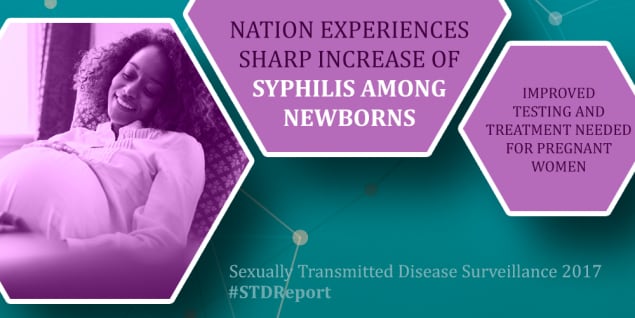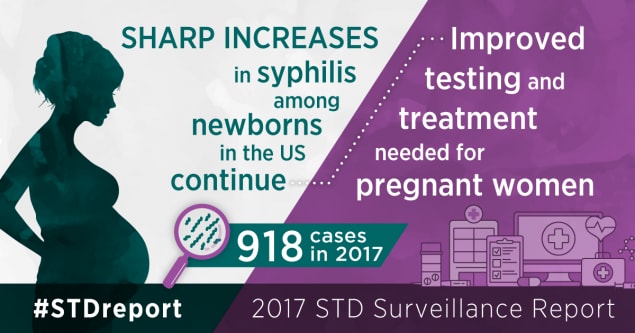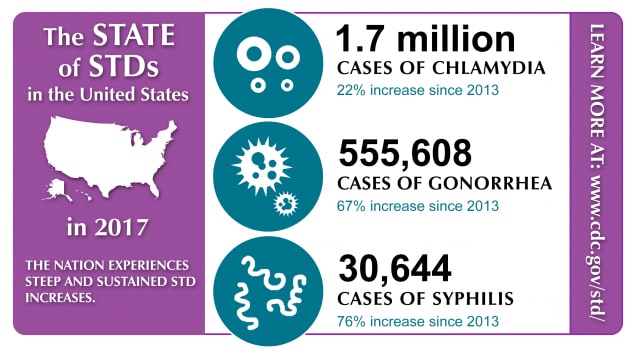Social Media Toolkit
On this page you can find sample social media messages and graphics for Twitter and Facebook. You can also join the online conversation by using #STDreport, or by retweeting @CDCSTD and sharing posts from the CDC STD Facebook page. Don’t miss the NEW Congenital Syphilis graphic and the State of STDs in 2017 Infographic!
Sample Twitter Posts
- JUST RELEASED! Newborn #syphilis cases more than double in 4 years, reaching 20-year high. Full #STDreport and more: https://go.usa.gov/xPrMA
- DYK? You can pass untreated #syphilis to your baby while pregnant. Here’s what you need to know to keep you both healthy: https://go.usa.gov/xPrMs #STDreport
- Clinicians: Syphilis AND congenital #syphilis is increasing. Here are actions you can take to stop it: https://go.usa.gov/xPrM6 #STDreport
- ALL pregnant women should be tested for syphilis once, BUT one test is not enough for EVERY woman. More info: https://go.usa.gov/xPrMF#STDreport
- Clinicians: Treat patients—especially pregnant women—with suspected or diagnosed syphilis IMMEDIATELY. Test and treat their partners, too! https://go.usa.gov/xPrMM #STDreport
- #Pregnant women: Get treated right away if you test positive for #syphilis. Don’t wait for your next visit! https://go.usa.gov/xPrMe #STDreport
- DYK? The U.S. is experiencing steep and sustained increases in #STDs. More: https://go.usa.gov/xPrMt
- U.S. hits FOURTH straight year of sharp overall increases in reportable #STDs. https://go.usa.gov/xPrMz
- Nearly 2.3 MILLION cases of #chlamydia, #gonorrhea & #syphilis diagnosed in US in 2017. More Info: https://go.usa.gov/xPre3
- From 2013-2017, #gonorrhea increased 67%, #syphilis nearly doubled, and #chlamydia remained extremely common. Prevention matters! https://go.usa.gov/xPrec
Sample Facebook Posts
- NEW! CDC’s 2017 STD Surveillance Report finds newborn syphilis cases more than double in 4 years, reaching 20-year high: https://go.usa.gov/xPrex
- The number of babies born with syphilis in 2017 = 918. That’s the most cases seen in the US since 1997. Let’s change that! Here’s how: https://go.usa.gov/xPrea
- Healthcare Providers: You play an important role in reducing the sharp rise in congenital syphilis. Actions you can take: https://go.usa.gov/xPreC
- Clinicians: Test ALL pregnant women for syphilis at the first prenatal visit, AND test high risk pregnant women – or those in areas of high prevalence – at about 28 weeks and at delivery: https://go.usa.gov/xPrer
- Clinicians: Patients with syphilis should be treated IMMEDIATELY, especially if they’re pregnant. Test and treat their sex partner to avoid reinfection. CDC’s STD Treatment Guidelines can help: https://go.usa.gov/xPreb
- DYK? ALL pregnant women should be tested for syphilis. Some women may need to be tested more. Talk to your healthcare provider about what’s right for you: https://go.usa.gov/xPreD
- Pregnant women: If you test positive for syphilis, be sure to get treatment right away. Your doctor can treat you with medicine that is safe for both you and your baby. More: https://go.usa.gov/xPreW
Graphics - Click for full size
Twitter Header

Facebook Cover

In-Stream Posts

Congenital Syphilis Graphic (multiple versions including hi-res)

Graphics from the State of STDs in 2017 (customizable infographic)

























.png)











No hay comentarios:
Publicar un comentario